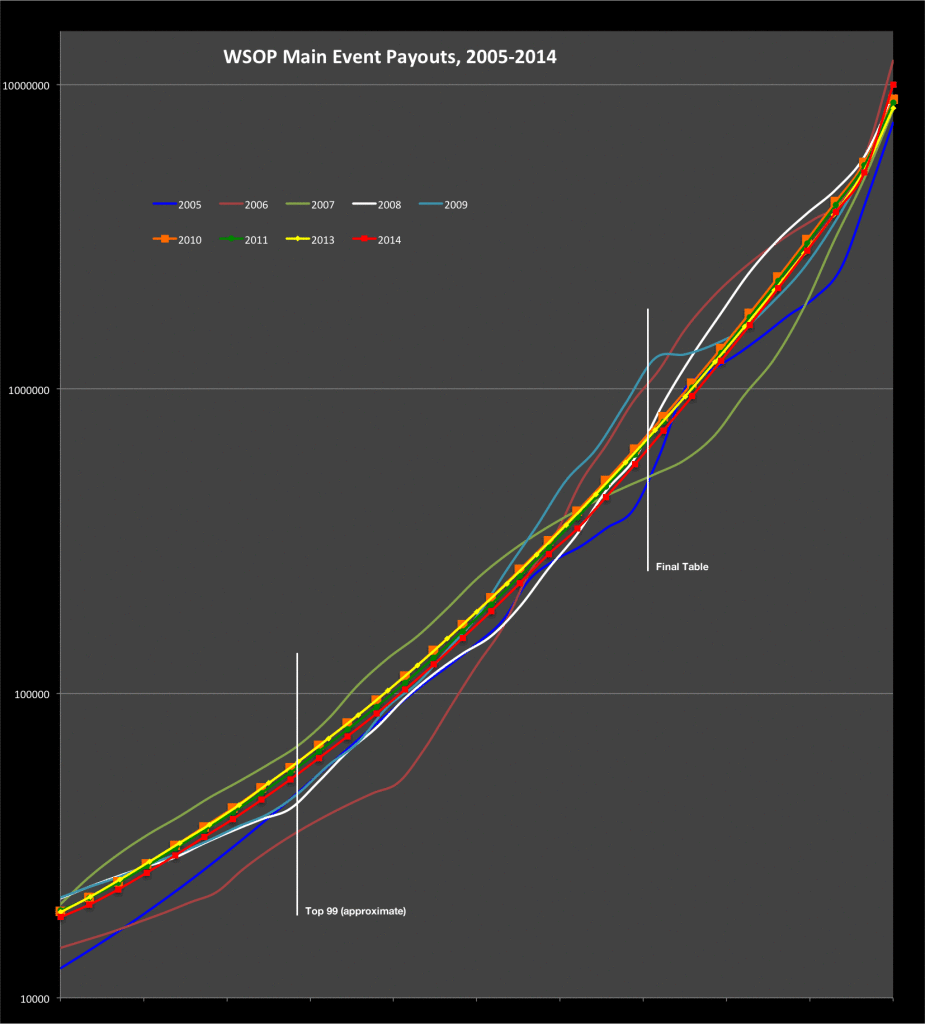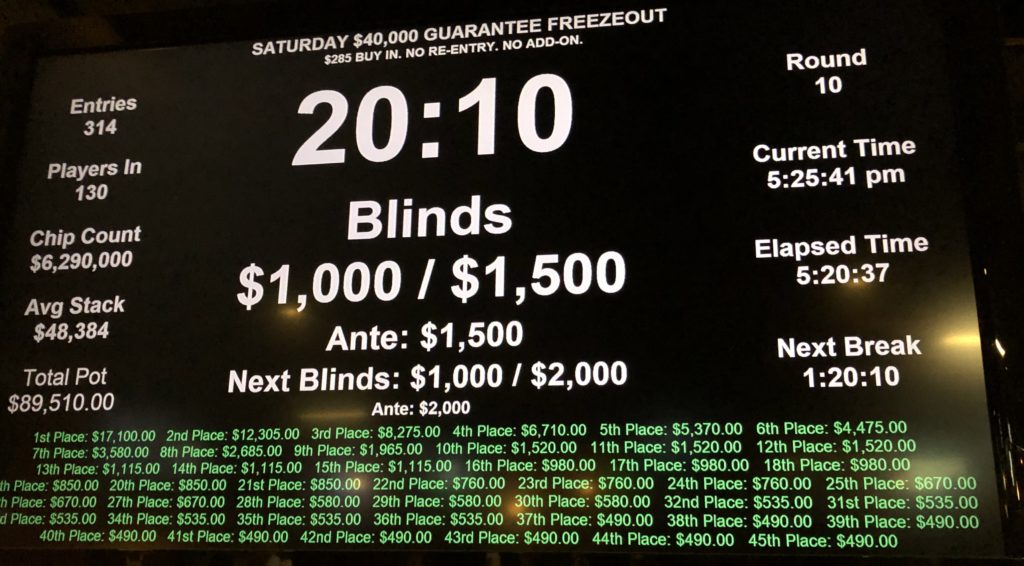By the time the Portland Meadows $40K GTD NLHE tournament rolled around in mid-January, I hadn’t played a single hand of poker for three weeks as a part of my retirement deal. A few people joked about me falling off the wagon, but my arrangement with my newly-retired wife was to not play on a regular basis. As I told people who asked: “I’m retired. I’m not dead.”
I got to Meadows fifteen minutes before the game began, only to find out immediate seating had already sold out half an hour earlier. I was alternate 43 in a rom with 200 seats for the tournament (we were playing 10-handed). Fortunately, the tournament was a freezeout.
PDX poker royalty waiting for start of the $40K @PDXmeadowspoker: podcaster Jonathan Levy (@2PokerGuys) and @PokerStars #PlatinumPass winner/PSPC 38th place finisher Jacki Burkhart (@jackiburkhart81) pic.twitter.com/hyptU0vdsj
— Poker Mutant (@pokermutant) January 19, 2019
Meadows had a very successful $30K GTD in December that went to $84K in the prize pool, so there wasn’t any concern about not making the guarantee, despite the lsat entry day of the Main Event of the Tulalip Pow Wow being held north of Seattle on the same day. Perhaps expecting a big turnout, the starting stack had been reduced from 25K to 20K.
I finally got a seat just over two-and-a-half hours into the tournament. Blinds were 250/500 with a big blind ante, and it was near the end of the level; not exactly where I want to be putting $300 ($285 plus $15 for the door fee) down for a game. True to form, I lost 3K on the first hand (I opened with [ax qx]), and within the first half hour nearing a break, I was down to 7600, with the big blind about to go up to 800.
Over the next hour, I managed to claw my way over the starting stack. They were still seating alternates ninety minutes after I got in—more than four hours into the tournament.
At the five hour mark (I’d only been playing for about half of that), I had 27500, but that was only about 18bb. I languished between 10—15bb for another 90 minutes before I got a crucial double, shoving [js 9s] from UTG1, getting called by [kx jx] and catching a 9. By 6:30, the board said there were 90 players remaining (from 314 entries, game started at noon).
My notes say the board was updated from 90 to 80 players remaining (we were still 10-handed) between 6:34 and 6:38. 45 players were getting paid.
Another 15 players were taken off the board by the time we got back from break at 6:59. I paid blinds early in the level, and was down to 11bb. Action was moving fast, and we didn’t have a full table, I paid another set of blinds by 7:16 and was down to 37K with the big blind at 4000. 56 players on the board. Got aces on the button, action folded to me, I shoved and nobody called. Down to 55.
Blinds went to 3000/6000 at 7:25. The board said there were 50 players left. We went hand-for-hand 10 minutes later. I had 32K.
A couple minutes later, the in the money announcement was made. On the next hand, the player in the big blind was all in for half of the big blind, lost the hand, and the dealer handed him a seat card to get his payout, as he’d been instructed.
That’s when things got weird.
The floor made an announcement that shocked me to the core. They’d somehow missed a table and were going to reset the count to 54.
Now, I once saw a tournament at Planet Hollwood blow through the bubble with people who left the room before the floor staff realized they were close to payouts, but that was a tournament with hundreds of players. We were down to literally six tables. Sure, you can’t count them on one hand, but how do you lose track of whether you’re at five or six or seven tables? Portland Meadows isn’t the Commerce Casino. It has a couple dozen tables in a room you can walk from end-to-end in less than fifteen seconds. And they had to have lost track of the count somewhere in the hour leading up to the bubble without anyone ever noticing. Cash game tables had started up, and an evening tournament had started at 7pm, but you’d think the tournament with the $90K prize pool might take a little precedence.
As a short stack, I’d laid down a couple of hands I’d have shoved in that last hour (which is why I’d been watching the count) and I assume there were a number of other players in my short stack situation that were doing the same thing. Now I was in a situation where I literally couldn’t do that because nobody had just walked the room double-checking the tables.
Anyway, I called a shove around 8pm from the BB with [7x 8x] against [jx 9x] and hit a 7 on the turn. We were down to 51 players again. I had 58K with big blind at 8000. Ten minutes later we went hand-for-hand a second time. And after about 20 minutes I was in the big blind with half my stack in the middle and [kd 5d] when Jason Adams limped inn from SB with a big stack and called my shove with [qx 6x]. Out on the bubble when he turns a queen and I split 45th place with a bustee from another table.
Anyway, the title of this post (if you’ve stayed this long) is a variation of something you (well, I) hear all the time, including at Meadows the other day. A player glances up at the payouts and mutters to the tale: “They pay too many places.” The implication, of course, is that the top prize is too small and that all those little payouts at the bottom are eating into their profit. Like they’re a lock on the win.

A few years back when the World Series of Poker extended the number of payouts in the Main Event from just over 10% of the field to 15%, there was great gnashing of teeth. What most people didn’t stop to calculate, though, was that even though 50% more people were getting payouts, the $15,000 each of those players got was one-and-a-half times the players’ contribution to the prize pool (1.5 x 5% = 7.5%) so with a little extra out for fees, around 8%. If you were going to get $8 million for first place, in other words, you were only going to get about $7.35 million. Poor baby.
Another piece I did for the 2015 WSOP was on the effect of the $10 million first-place guarantee. A chart I did for “Satisfaction Guarantee” showed how the jumps in payouts for the WSOP have been all over the place over the years (see the chart from that article above), until adjustments were made to the formula used to determine payouts. For the past couple of years there’s been an online payout calculator that you could use to determine what the prizes would be, based on the number of players in each event.
With all that in mind, people aren’t completely incorrect. The top prize in the Meadows $40K GTD was significantly smaller than it would have been in many other venues for a field of a similar size and prize pool. But it’s not because of the number of payouts.
Time for a big chart. Join me at the bottom.
This chart shows payouts from five different payout structures—two with 45 payouts and two with 54 (plus a 48-payout structure!)—in order from top (smallest) to bottom (1st). If you look at the bottom line, keep in mind that the brown lines represent payouts in the mid-January Meadows tournament (which paid 45 places). You might notice that the $17,100 payout is significantly smaller than the other four numbers, al of which are on the bigger side of the $20,000 mark, ranging from $20,005 to $21,691. How is there a discrepency of $3,000 or more in payouts? It’s less than 3% of the prize pool but it’s a 15% or greater reduction in the size of first place.
Now, in the old days, a tournament of 314 entries would probably have paid only 36 spots, rounding up to 4 full tables from 10% of the field. By my old friend the 2013 Venetian Deepstack 9/10 Handed Payout Structure, top prize would have paid 24%, or $21,480, more than $4,400 above the actual $17,100 scheduled first prize. The none $490 payouts to places 37 to 45 amounted to almost exactly that amount, but that value wasn’t all taken from the top spot.
How do I know? Because the Venetian payouts for 45 players (orange lines on the chart) has a top prize of 23.5%, which is $21,035, still almost $4,000 more than the Meadows prize. And the payouts for 37th through 45th are 0.54%: $485, just a fin under the same payouts at Meadows. With almost identical amounts paid to the fifth table, first place at the Venetian was still a lot more.
Personally, I think the counting mishap the other day could have been handled better by admitting a mistake and adjusting the payout table to pay 54 places. “But Mutant,” you cry, “that’s taking so much money from me, the winner of this here tournament!” Not so fast bucko.
The next column on the Venetian payout chart is for 54 places (red lines). Top prize is 23% ($20,595). with minimum payouts at $385 for the sixth table (46th to 54th) and $420 for the fifth table (37th to 45th).
For additional comparison, I’ve included two forms of payouts using the WSOP calculator. A tournament with 314 entries would pay 48 places (rounded up from 15% of the field, shown in green). I also show the payouts for 54 places (blue lines).
Pretty much every payout schedule except for Meadows has one thing in common: players at the final table are each paid a different amount, then there are three clusters of three payouts for 10th through 12th, 13th through 15th, and 16th through 18th. Then each full table is paid the same amount. For some reason, the payouts at Meadows increase in increments of three from position 30 on up to the final table. But that’s not really the problem, either.
The true culprit is at the final table. Between 9th and 8th, the payouts go from 2.2% to 3%, an increase of 36% where the other structures go up about 25%, The next jump at Meadows is to 4%, a relative increase of 33%. Again, it’s more than any of the other structures. And like compound interest, these bigger relative pay jumps have their effects that can be seen on the chart between payouts for 5th and 9th. The brown line represents a significantly larger payout than the others. More than a thousand dollars more than any other payout for 6th place ($4,475). By the final payouts, the more elegant exponential curves of the standard payouts have left the Meadows payout in the dust.
So the next time that guy sits down next to you at the table to grouse about all his money going to the min-cashers, you’ll be prepared to bore him to tilt with facts, figures, charts, and graphs.
This is not to pick on Portland Meadows or any other venue about their payout tables; it’s an article that’s been on my back burner for a long, long time. But if anyone wants advice on how to set up a payout table like the WSOP’s…


